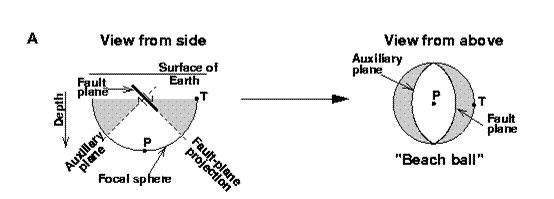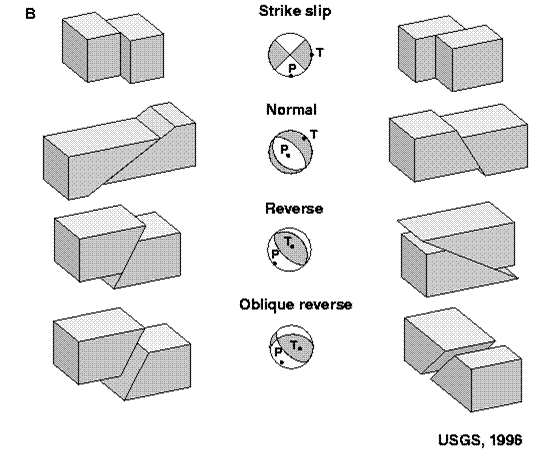Approfondimento: i meccanismi focali e le faglie. Il procedimento del brevetto ENEA RM2012A000637 può risultare molto utile in queste applicazioni. / Depth: the focal mechanisms and faults. The patent process ENEA RM2012A000637 can be very useful in these applications.
Approfondimento: i meccanismi focali e le faglie. Il procedimento del brevetto ENEA RM2012A000637 può risultare molto utile in queste applicazioni. / Depth: the focal mechanisms and faults. The patent process ENEA RM2012A000637 can be very useful in these applications.
Segnalato dal Dott. Giuseppe Cotellessa / Reported by Dr. Joseph Cotellessa
Il procedimento del brevetto ENEA RM2012A000637 può risultare molto utile nello studio dei terremoti perchè è in grado di integrare in modo molto sintetico i dati deterministici con la rivelazione dei dati sperimentali con quelli di tipo statistico per le differenti tipologie dei terremoti di tipo trascorrente, estensionale e compressivo.
Il meccanismo focale è un simbolo che permette di indicare contemporaneamente tre parametri geometrici della faglia che ha generato il terremoto: l’orientazione (strike) e la pendenza (dip) del piano di faglia, e la direzione del movimento su di esso (slip), cioè come si è mossa la faglia.

Figura 1: i tre parametri geometrici della faglia che ha generato il terremoto: l’orientazione (strike) e la pendenza (dip) del piano di faglia, e la direzione del movimento su di esso (slip), cioè come si è mossa la faglia (http://www.gps.alaska.edu).

Figura 2. Diagramma schematico di un meccanismo focale.
Veduta laterale (sinistra) e in pianta (destra) delle sfere focali. I quadranti in compressione (bianchi) e in dilatazione (grigi) sono separati da due piani, che sono i possibili piani di faglia.
Veduta laterale (sinistra) e in pianta (destra) delle sfere focali. I quadranti in compressione (bianchi) e in dilatazione (grigi) sono separati da due piani, che sono i possibili piani di faglia.
Un meccanismo focale contiene quindi indicazioni su due possibili piani di faglia, quello che ha generato il terremoto e quello ortogonale, il piano ausiliario, matematicamente equivalente. Per discriminare tra i due qual è quello che effettivamente si è mosso, bisogna avere conoscenze approfondite delle strutture geologiche esistenti nell’area in cui si è verificato il terremoto, guardare l’allineamento delle repliche dopo un terremoto, analizzare dati GPS ecc.
I meccanismi focali permettono di capire che tipo di movimento è avvenuto in un determinato terremoto, quindi come si è mossa l’area in risposta alla deformazione tettonica.Vediamo i diversi tipi di meccanismo focale e a quali faglie corrispondono.

Figura 3. Tipi di meccanismo focale e delle faglie associate. In alto il tipico terremoto trascorrente (molto comune in California lungo la faglia di San Andreas, ad esempio), al centro il terremoto estensionale (associato a faglie normali, caratteristico del nostro Appennino), più sotto il caso del terremoto compressivo (faglie inverse,
come quelli di maggio-giugno 2012 in Pianura Padana); infine in basso
un caso “obliquo”, in pratica una combinazione tra due tipi principali.
Il meccanismo focale ci dice che il terremoto può essere avvenuto su una faglia orientata NordOvest-SudEst o su una faglia orientata NordEst-SudOvest. Entrambe le faglie hanno pendenza verticale, infatti solo nel caso di un piano verticale abbiamo che la sua intersezione con una sfera è una linea dritta.
A destra e a sinistra del meccanismo in questione si trova un disegno che rappresenta le due possibili faglie.
Per capire la direzione del movimento (slip) su questi due piani dobbiamo osservare come sono disposte le aree grigie e le aree bianche nella “beachball“. I quadranti grigi indicano le zone sottoposte a compressione, quelli bianchi le zone in distensione.
Il caso dei terremoti della Pianura Padana di maggio-giugno 2012 è il terzo dall’alto in Figura 3 (in quel caso i piani sono orientati prevalentemente est-ovest). Il movimento dei blocchi a lato del mecanismo schematizza proprio il movimento delle faglie inverse sepolte sotto la Pianura Padana. Queste determinano l’accavallamento delle falde appenniniche sepolte al di sopra della placca adriatica, causando sollevamento del terreno e raccorciamento crostale.
ENGLISH
The procedure of the patent ENEA RM2012A000637 can be very useful in the study of earthquakes because it is capable of so much synthetic integrate deterministic data with the revelation of the experimental data with those of statistical type for the different types of transcurrent type earthquakes, extensional and compressive.
The focal mechanism is a symbol that allows you to simultaneously indicate three geometric parameters of the fault that generated the earthquake: orientation (strike) and the slope (dip) of the fault plane, and the direction of movement on it (slip) that is, as she moved the fault line.
Figure 1: The three geometric parameters of the fault that generated the earthquake: orientation (strike) and the slope (dip) of the fault plane, and the direction of movement on it (slip), that is, as has moved the fault (http://www.gps.alaska.edu).
The focal mechanisms are calculated from seismograms, ie the seismic signals recorded by seismometers, and are represented by the white and colored balls (the so-called "beach ball" or geographically oriented beach balls) (Figure 2).
Figure 2. Schematic diagram of a focal mechanism.
Side view (left) and plant (right) of the focal spheres. The compression dials (white) and dilation (gray) are separated by two floors, which are the possible fault planes.
These balls are the projection, on a horizontal plane, of the lower half of an imaginary sphere, the focal sphere, which contains the hypocenter of the earthquake (Figure 2). The two lines that divide the white areas from colored ones, have the intersection of two planes on the focal sphere. One of them is the fault that caused the earthquake.
A focal mechanism thus contains information on two possible fault planes, the one that generated the earthquake and the orthogonal, the auxiliary plane, mathematically equivalent. To discriminate between the two which is the one that actually moved, we must have detailed knowledge of existing geological structures in the area where the earthquake occurred, look at the alignment of the replicas after an earthquake, analyze GPS data etc.
The focal mechanisms allow you to understand what kind of movement has occurred in a given earthquake, and as we move the area in response to the deformation tettonica.Vediamo different types of focal mechanism and what are faults.
Figure 3. Types of focal mechanism and associated faults. In a typical high-slip earthquake (very common in California along the San Andreas fault, for example), the center of the earthquake extensional (associated with normal faults, typical of the Apennines), below the case of compressive earthquake (reverse faults, like those of May-June 2012 in the Po Valley); Finally, at the bottom an "oblique" case, in practice a combination of two main types.
Take the case of the first mechanism of Figure 2, the strike-slip mechanism, or strike slip.
The focal mechanism tells us that the earthquake may have occurred on a fault oriented Northwest-Southeast or on a fault oriented Northeast-Southwest. Both faults have vertical slope, in fact, only in the case of a vertical plane, we have that its intersection with a sphere is a straight line.
To the right and to the left of the mechanism in question is a drawing representing the two possible faults.
To understand the direction of movement (slip) on these two levels we have to see how the gray and white areas areas are arranged in the "beachball". The gray dials indicate the areas subjected to compression, the white ones the areas distension.
The case of earthquakes in the Po Valley of May-June 2012 is the third from the top in Figure 3 (in that case the plans are oriented predominantly east-west). The movement of the blocks at the side of the mecanismo summarizes precisely the reverse movement of the faults buried beneath the Po Valley. These determine the overlap of the Apennine slopes buried above the Adriatic plate, causing uplift and crustal shortening of the land.
Da:
https://ingvterremoti.wordpress.com/2012/06/18/approfondimento-i-meccanismi-focali-e-le-faglie-2/




Commenti
Posta un commento